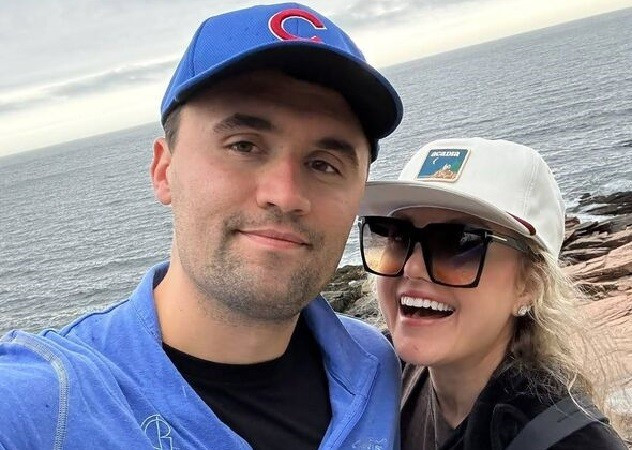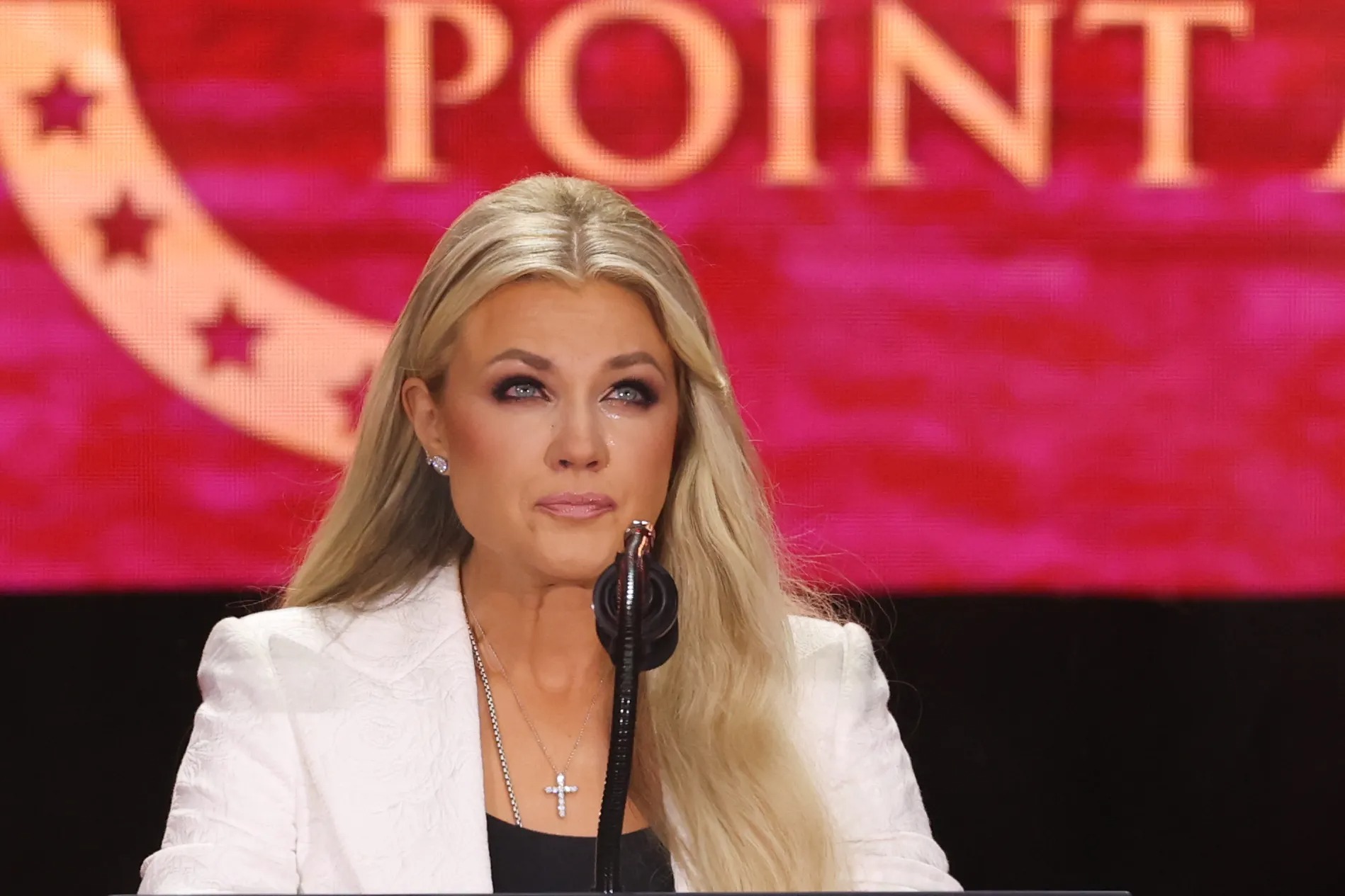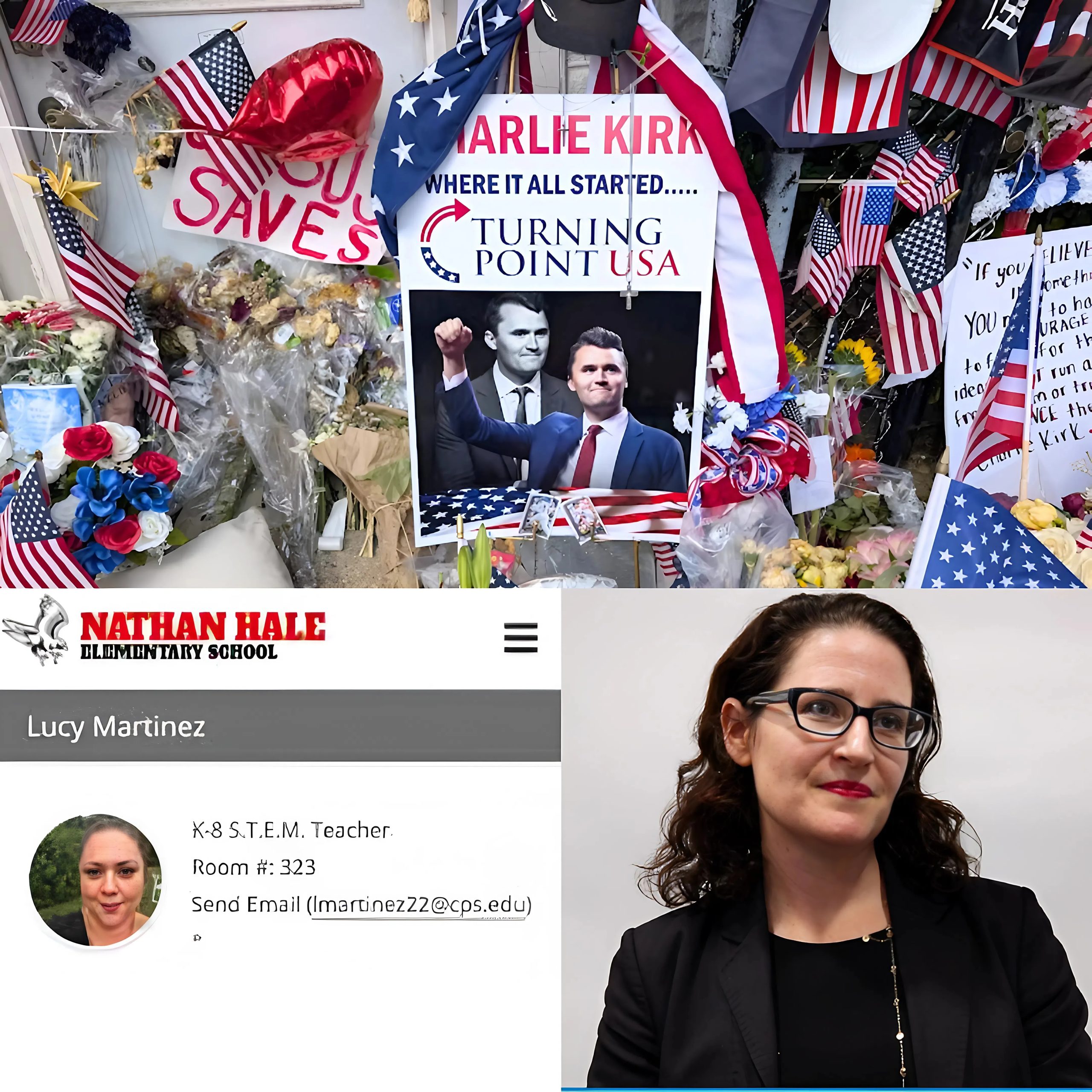It began with a file that should not have existed.
Not a folder.
Not a packet.
Not even a deliberately assembled dossier.
Just one lonely PDF attached to an encrypted email from an untraceable domain — the kind of email that investigators describe as
“built to disappear the moment you look away.”
Inside the PDF was a single line:
“Aurelius Holdings LLC → Erika Kirk — $400,000 — processed 03:17 AM.”
No signature.
No explanation.
No context.
The file wasn’t labeled, but the metadata carried one timestamp:
03:19 AM — one minute after the transfer was logged.
Someone captured that receipt in real time.
Someone watching.
Someone inside.

And someone who wanted the world to see it.
The email was sent simultaneously to three people:
- A mid-level financial journalist known for refusing NDAs
- An investigative archivist who runs a blog about dissolved companies
- And Megyn Kelly.
Only one of them responded publicly.
Only one of them told viewers, live, on air:
“Every dollar tells a story — and this one feels like a scream.”
That was the moment the story began.
The moment everything changed.
The moment people started asking questions that someone, somewhere, desperately hoped they never would.
MEGYN KELLY’S ON-AIR SHOCKWAVE
Megyn Kelly knew exactly what she was doing.
She didn’t tease the discovery.
She didn’t warm up the audience.
She didn’t soften the edges.
She opened her show holding the printed PDF between two fingers like evidence pulled from a crime scene.
“Someone wants this payment to be seen,” she said.
“Someone wants this story told.
And someone — clearly — wants it buried.”
She never claimed anything illegal.
Never used the words
bribe, payoff, cover-up, or crime.
But she didn’t have to.
The audience filled in the blanks.
Her producers later said that in the seconds after she shared the document, the studio’s internal analytics
flatlined, then spiked so hard it nearly crashed the system.
Tweets surged.
Clips spread.
Screenshots multiplied like spores.
Within two hours, #AureliusTransfer was the top trending tag in the country.
Within six hours, Aurelius Holdings LLC — a company nobody had heard of twelve hours earlier — became the most searched corporate entity in the United States.
Within twelve hours, researchers discovered the most chilling part:
Aurelius Holdings LLC had dissolved three days earlier.
Completely.
Cleanly.
Without a trace.
Megyn Kelly wasn’t the first to see the payment…
But she was the first to say:
“This vanishing act is not accidental.”
And with that, the hunt for the story behind the $400,000 began.

THE STRANGE RISE — AND SUDDEN DEATH — OF AURELIUS HOLDINGS LLC
Aurelius Holdings LLC was registered for exactly:
Its formation paperwork was flawless.
Its dissolution paperwork was flawless.
Everything in between?
A ghost town.
No staff.
No payroll.
No property.
No products.
No clients.
No website beyond a single landing page that read:
“Aurelius Holdings — Strategic Intent. Lasting Value.”
The website went offline 30 minutes after Megyn Kelly’s broadcast.
The domain was purchased through:
- A proxy service in Cyprus
- Paid for with anonymous cryptocurrency
- Routed through multiple privacy layers
Security consultants later said the company felt less like a business and more like a shell built for a single purpose — a purpose that involved exactly one payment of exactly $400,000 at exactly 03:17 AM.
Then it died.
No loose papers.
No filings.
No officers besides a “Manager” whose listed address was an abandoned mailbox in Nevada.
Aurelius Holdings LLC didn’t just close.
It erased itself.
And it did so with the precision of someone who planned the disappearance before the company ever existed.
THE QUIET PAYMENT THAT MADE THE LOUDEST NOISE
The $400,000 transfer itself was clean.
Too clean.
Processed through a Tier-1 financial institution.
No flags.
No holds.
No compliance pings.
According to the metadata, the payment description read only:
“Consulting — Q4 Retainer.”
But Aurelius Holdings had:
- No known clients
- No consulting records
- No contracts
- No public activity
- And no revenue large enough to justify a single payment of that size
And the recipient?
Erika Kirk.
Not her fund.
Not her organization.
Not an institutional entity.
Her personal account.
That detail alone turned a strange transaction into an international spectacle.
But the biggest question wasn’t:
Why was she paid?
It was:
Why was the payment made at 03:17 AM…
and who processed it at that hour?
Banks don’t spontaneously release nearly half a million dollars in the middle of the night.
Not unless someone deliberately triggered it.
Someone who didn’t want the transfer to be seen during normal business hours.
Someone who knew exactly what they were doing.
And someone who didn’t want anyone to ask why.

ERIKA KIRK: THE MESSAGE, THE MYSTERY, THE FALLOUT
In this fictional narrative, Erika Kirk learned about the leak the same way everyone else did:
Through the broadcast.
Through the hashtags.
Through the flood of speculation that swept across the internet like wildfire doused in gasoline.
She issued a short, carefully worded statement — neither defensive nor apologetic:
“I received a legitimate consulting payment for work performed over several months.
Any suggestion of wrongdoing is false.
I will not comment on private professional matters.”
It was a clean message.
Too clean, some said.
But the real mystery wasn’t her words.
It was the silence that followed.
Hours passed.
Then days.
Then nearly a week.
Not a single additional detail leaked from her camp.
Not a single follow-up comment.
Not a single clarification from advisors.
Not a single correction from attorneys.
It was as if the payment, the paperwork, the entire story had been sealed behind an invisible barrier.
And when barriers appear that suddenly…
People start wondering who built them.
And why.
CHARLIE KIRK AND THE WHISPERS OF “SOMETHING BIG”
While Erika remained silent, another fictionalized storm brewed around Charlie Kirk.
Not for what he said.
But for what someone claimed he said.
A leaked message — unattributed, unsourced, unverifiable — circulated containing one line allegedly from Charlie:
“There’s something big inside my own circles — bigger than I realized.”
No date.
No context.
No recipient.
Just those twelve words.
There was no proof it was real.
No screenshot.
No metadata.
No chain of custody.
But in the tabloid-fiction world where this story lives, the public didn’t care about verification.
They cared about implications.
What was “something big”?
Who was involved?
And what did it have to do with a vanished LLC and a $400,000 midnight transfer?
Charlie issued a statement calling the circulating message:
“A fabricated fragment designed to stir chaos.”
But the damage was done.
Because once the public believes you might know something…
They assume you do.
And once they assume you know something…
They want you to say it.

THE INSIDER KNOWN ONLY AS “GLASS LANTERN”
Three days after Megyn Kelly’s broadcast, a burner account appeared on an encrypted message board known for whistleblower activity.
The username:
GlassLantern_317
The “317” was not subtle.
The posts were scattered — frantic, fragmented, and dripping with the kind of tension that suggests either deep knowledge or deep paranoia.
Among the messages:
“The payment wasn’t the beginning. It was the end.”
“She wasn’t supposed to know where it came from.”
“The company dissolved because it already served its purpose.”
“Charlie’s message wasn’t about the payment — it was about the fallout.”
Investigators couldn’t verify the posts.
But nothing poured gasoline on a rumor like a mysterious anonymous insider.
And the internet drank every drop.
One message, though, stood out from the others:
“The accountant didn’t disappear. He was removed.”
Nobody knew what that meant.
Not yet.
THE ACCOUNTANT WHO SPILLED THE FIRST DROP
Before Aurelius vanished, only one person had interacted with the company in any verifiable capacity:
Its contracted accountant — Leonard Hale.
A quiet, meticulous man in his forties known for three things:
- His perfect filing history
- His obsession with timestamp precision
- And his monthly habit of backing up every corporate ledger he handled
It was Hale’s digital archive — specifically a version saved 17 minutes before dissolution — that contained the only known trace of the payment order.
Not the receipt.
Not the confirmation.
But the instruction.
A command to transfer $400,000 to:
“EK — primary personal.”
The initials alone weren’t incriminating.
But the timing was.
The instruction timestamp:
03:06 AM
The processing timestamp:
03:17 AM
Eleven minutes.
Who moves $400,000 in eleven minutes?
And who issues a transfer order through a company that would cease to exist less than three days later?

A TIMELINE THAT DOESN’T ADD UP
The more investigators in this fictional storyline dug, the stranger the timeline became.
- 03:06 AM — Transfer instruction issued
- 03:17 AM — Payment processed
- 03:18 AM — Receipt generated (leaked later)
- 03:19 AM — Metadata timestamp from whistleblower
- 3 days later — Aurelius files dissolution
- 72 hours after that — All digital infrastructure disappears
- 12 hours later — Domain goes offline
- 18 hours later — Accountant Leonard Hale goes “on leave”
- Permanently
Nobody knew where he went.
No missing person report.
No family statements.
He had simply…
Stepped out of life.
Like a character written out of a script.
Which only made the public more certain:
This story wasn’t just about a payment.
It was about a pattern.
A pattern someone desperately wanted erased.
THE SHADOW NETWORK BEHIND THE SHADOW COMPANY
In the absence of facts, speculation flourished.
Security analysts — fictional ones in this story — began constructing possible networks behind the Aurelius payment, attempting to identify who might create a temporary company with such surgical precision.
Their reports (published online, circulated anonymously, later deleted in some cases) described the same pattern:
- Companies with short lifespans
- Perfect paperwork
- Minimal digital fingerprints
- Single-purpose financial events
- Traceable to nothing and no one
These weren’t businesses.
They were instruments.
Like disposable tools designed to perform one task, then vanish.
What task, nobody knew.
But one analyst wrote:
“Aurelius was not the first.
Aurelius was not the biggest.
Aurelius was simply the first that leaked.”
And that — more than the payment itself — terrified people.
Not the money.
Not the transfer.
The possibility that there were more.
Many more.
And that most had succeeded in disappearing completely.
But someone woke it.
Someone logged in under an administrative ID never used before.
A one-time credential.
A one-purpose login.
Then vanished.
Security experts call these “ghost credentials” — access profiles created solely to execute a task and self-delete afterward.
No audit trail.
No identity.
No trace.
Whoever issued that transfer…
Knew what they were doing.
Knew how to hide.
And knew precisely how long the company had left to live.
Just as the public began to tire of speculation, a final file appeared.
Not a PDF.
Not a text log.
A voicemail recording.
Sent anonymously to the original journalist who had received the first email.
The voice was distorted.
Digitally masked.
Impossible to identify.
But the message was unmistakably human:
“You’re looking at the wrong person.
Erika wasn’t the target.
She was the trailhead.
Follow the sweep account.
Follow the $125,000.
That’s where the real story starts.”
The payment wasn’t the end.
It wasn’t even the middle.
It was the beginning of a trail that someone expected the public to follow.
A trail that led away from Erika.
Away from Charlie.
Away from Aurelius.
And toward something larger.
Something hidden.
Something that — according to the anonymous voice — was “still very active.”
The message ended with:
“You’ve seen the leak.
But you haven’t seen the purpose.”
Then silence.
The investigation had only just begun.
In the months following the fictional Aurelius incident, analysts continued pulling threads.
Each thread connected to another.
Some broke.
Some led nowhere.
Some connected to things nobody expected.
But all of them pointed to one undeniable truth:
The Aurelius transfer was not an anomaly.
It was a pattern.
A pattern designed by someone who understood:
Meet Lucy Martinez — a Chicago elementary school teacher who publicly mocked Charlie Kirk’s de@th, calling it “karma.”ABC

It began, like most modern scandals do, with a post. A single, smug sentence typed late at night, half meant as a joke, half meant to sting.
“Maybe karma finally caught up with him,” wrote Lucy Martinez, an elementary school teacher from Chicago, in response to the death of conservative activist Charlie Kirk.
The post was short — cruelly short. But the damage was immediate. Within minutes, screenshots began to spread across X (formerly Twitter), Telegram, and Facebook. By morning, her name was trending nationwide. Parents were calling her school. Reporters were camped outside her apartment. And the country was once again asking a painful question: What happens when the people teaching our children lose all sense of compassion?

THE WOMAN BEHIND THE POST
Lucy Martinez was, by all appearances, an ordinary public school teacher. She taught fifth grade at a small elementary school in the south side of Chicago. Her students liked her. She posted motivational quotes on her classroom walls. She ran an after-school art club.
But online, Lucy had a different persona.
Under the handle @NoKingsLucy, she frequently shared memes and commentary mocking conservative figures, especially those associated with faith-based or traditional causes. To her, it was humor — a form of digital rebellion. To many others, it was a growing sign of hostility coming from those who claim to represent “tolerance.”
When Charlie Kirk’s tragic passing was confirmed, Lucy couldn’t resist. She typed that fateful line — “Maybe karma finally caught up with him” — hit post, and went to sleep.
By sunrise, her entire life had changed.
THE INTERNET ERUPTS
The outrage was instant and volcanic. Former colleagues condemned the remark. Parents of her students began contacting the school board, demanding to know how someone capable of mocking death could be trusted to teach children empathy.
Prominent figures weighed in too. Pete Hegseth called the remark “a symptom of moral collapse.” David Muir discussed it on World News Tonight, calling it “a disturbing glimpse into how social media desensitizes even our educators.”
But the loudest reaction came from those who once marched beside Lucy in rallies and online forums. Many members of the “No Kings” protest movement — which began as a grassroots call for accountability and democratic values — suddenly found themselves caught in a moral crossfire.
Did Lucy’s comment represent their values? Or expose their contradictions?
“THE MOVEMENT OF LOVE”
The “No Kings” movement, founded in the wake of Trump’s controversial post-presidency rallies, was built on an idea: that America must reject “strongman politics.” Its slogans preached love, equality, and unity.
But as the movement grew, its tone shifted. Activists began using words like “resistance,” “purge,” and “payback.” Online forums turned meaner, darker. What started as peaceful protest began to reek of vengeance.
And now, Lucy Martinez had become its face — the perfect symbol of what happens when “love” becomes a weapon.
In one viral tweet, conservative commentator Jack Posobiec wrote:
“Lucy didn’t just mock a man’s death. She revealed the soul of her movement. They preach love, but cheer hate.”
That post alone was shared more than 60,000 times.

“SHE TEACHES OUR KIDS”
Parents in Lucy’s district were horrified. One mother, speaking anonymously, said:
“My son had Ms. Martinez in fourth grade. She taught him to ‘be kind, even when it’s hard.’ Now I find out she laughed at someone’s death? What message does that send?”
The school district issued a statement calling her post “unacceptable and inconsistent with the values of our institution.” Lucy was placed on administrative leave pending review.
Meanwhile, online activists — both for and against her — began digging into her history. Old tweets resurfaced. Photos from No Kings rallies appeared, showing Lucy holding a sign that read “End the Era of Tyrants.”
Some applauded her courage. Others saw something else: hypocrisy.
THE APOLOGY THAT WASN’T
Two days later, Lucy deleted her accounts and issued a brief statement through her attorney.
“My comment was meant as dark humor, not cruelty. I did not intend to celebrate death. I regret the harm my words caused.”
But by then, it was too late. Screenshots don’t disappear. The public had already made up its mind.
For critics, her apology rang hollow — the classic “sorry if you were offended” routine. For supporters, it was proof that she was being bullied for “speaking truth to power.”
The No Kings organization released its own carefully worded response:
“While we do not condone celebrating loss of life, we understand Lucy’s frustration with systemic oppression and corruption.”
The statement backfired spectacularly. What was meant as compassion came off as justification.
THE HEART OF THE HYPOCRISY
At the center of the firestorm was a haunting irony.
The “No Kings” movement had built its brand on moral superiority — claiming to fight for love, empathy, and justice. Yet its most visible voices were now defending cruelty, as long as it was directed at the “right” targets.
As one commentator wrote:
“When you cheer for someone’s death, you’ve stopped fighting tyranny and started becoming it.”
The movement’s leaders tried to pivot, focusing on other causes — but Lucy’s image, her smirk, her post, refused to fade. Protesters who once carried signs that read “Love Wins” now found themselves mocked with counter-signs saying “Hate Hides.”

THE REAL COST
While the online world devoured the scandal, real lives continued to unravel offline.
Lucy’s students were reassigned to other teachers. Her colleagues avoided her. Local reporters followed her car. Anonymous letters arrived at her doorstep — some sympathetic, some vile.
Her friends said she spent most of her time alone, refusing interviews, reading articles about herself through tears.
“She made a mistake,” one friend said. “But what’s happening to her now — it’s like the world forgot how to forgive.”
And yet, others argued that forgiveness begins with accountability.
“If you mock death publicly,” said one Chicago pastor, “you’re not just making a mistake. You’re revealing what’s missing inside you.”
A NATION WATCHING ITSELF
The story of Lucy Martinez isn’t just about one teacher. It’s about what’s happening to all of us.
Every day, Americans log online and hurl words they’d never say face-to-face. Every day, empathy gets smaller, outrage gets louder, and compassion gets traded for clout.
In that sense, Lucy’s post wasn’t an isolated sin. It was a mirror — one that showed a culture addicted to cruelty disguised as virtue.
The No Kings movement wanted to tear down crowns. Instead, it built new thrones for self-righteousness.
THE LESSON LEFT BEHIND
When asked later what he thought of the controversy, Charlie Kirk’s close friend Pete Hegseth offered a simple response:
“You can’t claim to love people while laughing at their deaths. The moment you do, you’re not fighting for justice — you’re fighting for yourself.”
That quote was shared more than Lucy’s original post.
Maybe that’s the one good thing that came from it. Maybe, for a moment, people remembered what decency sounds like.
As for Lucy, her teaching license remains under review. Whether she returns to the classroom or not, her story has already become a cautionary tale — a warning about how easy it is to lose your humanity one “funny” post at a time.
In the end, Lucy Martinez thought she was making a joke. But America wasn’t laughing.
And somewhere between those two realities lies the lesson every teacher — and every citizen — should remember:
Words matter. Compassion matters. And once you forget that, no movement, no slogan, and no cause can make you right again.
The media’s treatment of Lucy Martinez reflected the changing landscape of news in the digital age. Every aspect of her life became fodder for headlines, from childhood photos resurfacing to accounts of her hobbies, political opinions, and volunteer work. Some outlets portrayed her as a villain; others framed her as a cautionary tale of digital recklessness.
This attention was not without consequence. Students and teachers across the country began examining their own online presence. Districts initiated social media workshops for educators, highlighting the potential for posts to go viral in unintended ways. Policy makers debated the balance between personal freedom and professional responsibility.
Lucy herself watched it all unfold with a mixture of horror and disbelief. One friend recounted, “She keeps saying, ‘It’s like I don’t even recognize my own life anymore.’ Every article, every tweet, every video — it’s a constant reminder of one mistake, magnified to infinity.”

